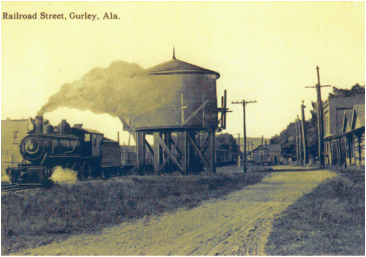
A Glimpse of Gurley's History
Nestled in the southern foothills of the Appalachian Mountains, Gurley, Alabama is located in a beautiful fertile valley which is approximately three miles wide and six miles long. The community lies 16 miles east of Huntsville and is bordered on the west by the Flint River and on the east by the Paint Rock River.
As early as 1830, several families purchased land and built homes in what was then a densely wooded area. The surrounding forests provided an abundance of wild game for the settlers. Families and the natural spring and wells were known for the plentiful supply of fresh pure water. John Gurley was one of these settlers. Through hard work, he became the owner of the greater portion of lands east and north of the present town of Gurley.
When the Memphis and Charleston Railroad laid track through Gurley in 1857, John Gurley built a large cedar water tank near the railroad. Water was piped to this tank from a spring on Keel Mountain, which overlooks the town on its southern border. Settlers who built their homes near the water tank tapped into the lines and Gurley became the first town in Madison County to have its own water works system.
The son of John Gurley, Captain Frank B. Gurley, who was a Confederate veteran, donated a one square mile area extending in equal proportions from the water tank for the town site. The town was incorporated in 1890 with a population of 250 residents. In just one year the population of Gurley grew to 1,000. The town had a fine mercantile business and boasted of numerous manufacturing establishments including a cedar basket factory a stave and hoop factory and Eagle Pencil Mill. The first post office was established in 1896 and the name of the town officially became Gurleysville. Not long thereafter the town's name was shortened to Gurley.
As of 1891, there were three churches in Gurley. The Cumberland Presbyterian Church played an integral role in the educational development of the community. They along with the Robert Donnell Presbytery, established the Robert Donnell Academy in 1893 which was a high school and a two year college in Gurley.
In 1907, the state legislature passed a bill to establish a county high school in each county of the state. Gurley competed with Huntsville for the location of the new county high school. Governor Comer visited both towns and selected Gurley as the site for the school after being influenced by the overwhelming community support. Four and one half acres of land which included the two story brick building housing the Robert Donnell Academy were donated, along with a $2500.00 donation from the city of Gurley to support the operation of the new school.
As late as the 1940's and 1950's, Gurley still had a drug store, a bank, five grocery stores, and its own movie theater. The Joy Theater was owned and operated by Mr. and Mrs. Harris Formby.
Gurley began to change as their neighbor, Huntsville, changed. Huntsville was still a cotton market town in 1950 when Senator John Sparkman brought Wernher von Braun and a team of German rocket scientists to Huntsville. These men moved the United States into the space age transforming a once small town into a cosmopolitan community. As Huntsville grew, Gurley residents sought jobs and shopping in the growing city.
In the last two hundred years, Gurley has seen many changes, but nonetheless it maintains its heritage and reputation for southern hospitality.
Photo courtesy of http://www.contactez.net/gurleyalabama
